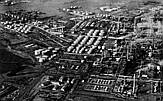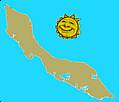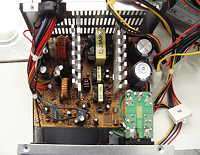

Donner und Blitzen!
and what to do about it

Baron Frankenstein would love it here
As an electrical engineer explained to me, when a power surge traveling through a line arrives at a house, it bounces back through that line, to bounce forth again, the process repeating itself until the wave is extinguished. We have many such surges, first because the utility plants have this nasty habit of exploding their generators; but also because most of the lines are strung along poles and lightning just loves to seek them out. Crash - poof! and there you go.
 large-scale alternative approach |
| In April 2008, CSPOSI (Concentrated Solar Power Open Source Initiative - not what you'd call snappy) has opened a "Showcase Curaçao" page on renewable power generation here. There's a forum as well. With Isla refinery and our present Aqualectra utility to contend with, they need all the help they can get. Have a look, by all means; but be warned, this is not entertainment. While my own approach has been definitely low-key and small-scale, SCPOSI wants to go all the way and I'm not saying they're wrong. I do have some reservations, which I spell out here. |
This has resulted in blown-up fax machines, burned-out video recorders, incinerated car battery chargers, combusted answering machines, and many more conflagrated computers and peripherals than I care to figure. Those power surges are so vicious, they just laugh at surge suppressors. HiFi amplifiers and audio recorders really are much sturdier—we have not lost one. We have also been lucky with refrigerators, air conditioners and freezers, but that's unusual; there, most damage occurs because of short drop-outs and brown-outs.
We never got any compensation for the damage from the utility company—it is state-owned, which explains a lot. It got that way in the 80s, when all over the world that sort of company was being privatized. Under IMF pressure, the utilities are trying to find a partner for re-privatization, but it seems hard to lure a sucker into the trap. After they finally signed an agreement (with an ENRON affiliate, Mirant) these guys in July 2006 retracted from all Caribbean ventures (now that's the proper Thesaurus word!) Mirant declared Curaçao utilities were doing quite well, which we can believe.
The most incredible story is that of the exploded power back-up supply (UPS), that literally gave a bang and died. A guy working at the factory expressed his amazement at the ferociousness of our spikes; they'd never heard of that happening before.Apart from that, we were much plagued by voltage fluctuations (phase problems), which finally stopped when they changed the aluminum supply line for a copper one and the contacts did not have corrosion trouble any more.
The most shameful story is that our energy company has paid for damages only the first time we had a complaint. Even when they had their own meter blow up and had to replace it. I was actually surprised they did not charge us for that!

lightning by Bill Elder
MAD Magazine: Frank N. Stein!
I wouldn't believe it if you told me this
On a later occasion I was working on a computer when Willy and Natasha came in. They stood at the opposite side of the table when a long spark jumped from the ceiling to the floor, right between us, with a nice crackle.
Needless to say, we developed this habit of switching all sensitive equipment off when the skies darkened for another show. It didn't really help.
A computer dealer told me the story how, in St. Maarten, lightning struck a place, then traveled underground and proceeded to ruin all computers across the street as well. One fell swoop. But you don't really have to believe that flash went underground; having lightning strike next door guarantees enough trouble on its own.

Going Solar
and selling their Curaçao Utilities Company shares (25.5%) to Japan Marubeni.
C.U.C. is further owned by Aqualectra and Mitsubishi, but Mirant also owned $40M preferred Aqualectra shares.
| Priceless Price Story This information mainly comes from a letter Lover's ice and juice factory delivered at the Bestuurscollege end November 2005. It carried 11,000 sympathizing signatures. Just some highlights from newspaper Amigoe: - Between 2000 and 2004, general costs of Aqualectra have gone up with ANG55M (US$25M) - In the same period, Aqualectra spent ANG44.4M (US$20M) on consultants' fees - Curaçao water prices are two times those of Aruba; electricity three times - Aqualectra charged consumers ANG410M more because of higher fuel prices, which went up by only ANG137M; difference ANG237M. In the same period, Aqualectra borrowed ANG330M. As Lover's Ice might well ask, where did all that money go? Just a nasty-minded suggestion: Maybe to Mario Evertsz' (who used to be a director of Kodela, later turned into to Aqualectra) EMG Effective Management Group? - Salaries for 5 directors over 4 years totalled ANG36M. Don't forget, Aqualectra seems not to have produced any yearly accounting reports since umpteen years. If all this reminds you of DCA, same here. Also mind that 11,000 signatures represent almost 13% of the population; or 26% to 52% of families. In 2006, Aqualectra finally got around to publishing a report - over 2005. I really don't know about all those years before then, and suspect nobody does. Anyway, in 2005 Aqualectra all of a sudden has made a nice fat profit of ANG40 million. |

another ripping rip-off
The Price We Pay We are not discussing the water price, even if it works out at about 10 guilders/m³. Anybody can understand that distilled seawater is more expensive than the pumped-up and filtered variety. Still, in the desalination plant of Tampa (Florida, USA) the projected water price is $0.659/m³. While this probably does not include distribution, it's outrageous to think that would cost over 8 times the production price. In Holland—water land, water price is about €1.52/m³ or ANG3.50 or US$1.95, of which some 13% is tax. (But in Amsterdam not every house even has a water meter—yet.)
However, electricity is quite another story. Average price in Holland is €0.08/KW; in the USA ¢8/KW. For NY, about the most expensive of the USA, it's US$ 0.11. We pay (in 2006) ANG0.533/KW or €0.233; say $0.30. Rather expensive? Yes, rather: In Iraq, where in 2006 the mains leaves you in the dark even more often then here, there are private 'generator men' who supply a couple of blocks for 10 hours per night. Their price per kilowatt is a whopping ANG0.177. Only.
When you come here, you will notice that all over the island large transformers are mounted high up in poles. They built a really heavy construction uphill from us, with a big, solid (looking) transformer on it. It gave up almost right away; after a couple of hours, or maybe days, they had it fixed again. And again. After which, in a very short time, in the middle of a black night it just literally exploded with a very impressive Big Bang.
one more horror story
They then replaced it with a much smaller one, that's obviously of less capacity than what they figured they need for the neighborhood. So I don't know how long it will last. Prophetic words, that: It blew up once again early 2003, with a nice "bang!"—this time because the line had been short-circuited by a kid flying a kite. Shades of Benny Franklin? One thing is for sure, when that once-a-century hurricane hits us, just like in St. Maarten a couple of years ago the power lines will all go down: the end of the line. We may then call them bottom lines. Huh huh.Pollution and other nasty problems Way back when, a trial was made with a wind generator on our north coast. As this was not exactly what you'd call a success, naturally it was decided to put still more in. This reminds me of C.S. Forester's The General: If a tactic doesn't work, that can be only because it has not been applied stringently enough: If one battalion has been slaughtered, pour four battalions into the gap; if one wind generator gives disappointing results, put in twenty!
The two locations for the wind generators were reserved for conservation under the E.O.P. [Island Development Plan], but of course they got their permits anyway.
At Fuikbaai, it turned out in July 2004, long after building had started, that there were no building licenses for the new reverse osmosis plant (water production). The discharge pipe runs over a terrain where not even a week-end house may be built by the owner (whose permission they also forgot to get), delivering a maximum of 1.4m3 of brine per minute.
They then got their permits and licenses in less than a week. Now suppose you try the same trick. Admittedly, their nuisance act permit did not come through, but they only need that when they start operating. Or a year or so later, maybe? As Aqualectra originally wanted the exhaust at a depth of 30m and Carmabi (Caraïbisch Marine Biologisch Instituut) indicated a depth of 90, Aqualectra now figures a compromise of 50m - which puts it right smack in the best preserved coral reef we still seem to have.
Milieudienst by the end of 2004 discovered Aqualectra was still infringing many directions and, generally, seemed to do pretty much what they liked without bothering too much about laws. Their operations are supervised by an outfit called EcoVision, a fine-sounding name. As this was not the first warning, Aqualectra was now threatened with a fine.
Upon leaving and dismantling their installations next to the harbor entrance, Aqualectra announced they would clean up the ground below, heavily polluted. But when this turned out to be too expensive, they would not. Naturally. But of course! What did we expect of these guys anyway?
The ISO certificate
November 2005 was a month marked by many hours of no electricity for a large part of the island. It was so bad people went over to the Aqualectra office to deliver the spoiled meat from their freezers. The same month, Aqualectra proudly announced they had acquired the prestigious Lloyd's New ISO 14001 2004 certificate. They didn't even properly explain what that was supposed to be for, so we'll inform you: It means Aqualectra'senvironmental management systemis in compliance with the ISO standard. This is a belly-shaking laugh.
If you want to check out for yourself, you can find part of the questionnaire here (sorry, gone!). A short look at it is enough to convince you that Aqualectra has just gone through the motions and filled out "YES" everywhere, like a cribbing student at school filling out a test paper. Just a few samples of the 351 questions:
— Do you consider significant environmental aspects as you maintain your environmental management system?
— Do your procedures help you to determine how legal and other requirements apply to your environmental aspects?
— Do you maintain your organization's environmental objectives and targets?
[If an answer is NO, don't worry—just check YES at the following question, asking if you're working on it])
Aqualectra must have overlooked small and slightly embarrassing items like the windmills at Playa Kanoa, the new BOO plant built without any permits even applied for, and the osmosis plant at Fuikbaai. And who knows what else we may not ever discover. Aqualectra also states the Lloyd's audit isexpensive. Well, maybe, but not as expensive as their own tariffs: You can buy the questionnaire for the grand sum of US$90. Giving them the proverbial benefit, which they emphatically do not deserve, they may possibly have paid more for the actual audit. Which leaves us with no reply to the hot question:
One may well wonder what Lloyd's does for thatprestigiousaudit — just look if all the YES answers have been checked? After having cashed the check — first things first.
Aqualectra maintains they have another company audit for them which reports to Lloyd's. They didn't tell which other company.
Nice Try
Price up — again?!
February 2005, energy prices were hitched up once again by 8%. Leakage losses of Aqualectra should have been reduced to 21% by 2004, but as it turned out they were still at 35% — in other words, not a thing had been done to economize the operation.
Aqualectra denied this and huffily stated leakage was down to 33%.
According to Norbert George's book Koninkrijksbeleid fataal voor Curaçao, the Kodela power leakage loss is an incredible 97%.
Remission? It's a fine old tradition that, when you don't pay up in time (which can be less than 1 week — much less) Aqualectra will cut your supply. But on instigation of deputy Pierre, in August 2006 Aqualectra announced they will restore supplies to 2600 defaulters (which means we will pay for them.) These guys owe Aqualectra a total of 10M, or an average of almost 4K guilders. Which is quite a lot. Which means Aqualectra waited a much longer time than for the rest of us to cut them off. The burning question now is: Why?And another burning question isNow, how will these debts get paid off?
But we apologize for our childishness in bringing it up at all. You're right, this is peanuts compared with Aqualectra's alleged 97% waste
The occasion was adorned with a holy mass — no kidding. Brings up yet another question: Who's paying for that? Holy masses or any other religious ceremonies never come free. Seems we have no church-state separation, except in the constitution — let's say it once again:Only marks on paper.
upside-down stunt In 2005 Lovers Industrial Corporation director Carlos Monk started publicly protesting Aqualectra's high tariffs. For Lovers, producing ice cream and juice among other products, the high energy prices are killing. Lovers took out full-page ads in the local newspapers, accusing Aqualectra of having robbed us of ANG215M in the past few years. It is Monk's contention that Aqualectra's prices are twice what they should be, and Lovers have also lodged an appeal with the island government in an attempt to force them to lower prices.
Aqualectra's reaction (Amigoe, 2005-11-05) was that they were being wronged by Lovers, and director Steven Martina felt that, therefore,Lovers should go to court! To get a court order to stop their own advertisements?
EEK! An Audit! After all those years, in August 2006 Deputy Nelson Pierre was finally ready for a financial audit of Aqualectra. Shareholders Mirant and STiP (= the government) and commissaries agreed. But Aqualectra management resented it had not been involved in the choice of the auditor (Vantage) and refused. (We would all just love to be able to do that for a tax audit.) Deputy Pierre threatened to fire Aqualectra director Anthon Casperson and others if they continued obstructing the audit.
Curoil will be audited as well; they wanted a week to get prepared but no such luck. (Their director is Humberto de Castro who, interestingly, is a competitor of Casperson for the function of Aqualectra's top manager.)
When Aqualectra still hadn't agreed on August 28, Pierre threatened to publish all details on deals with Mirant, BOO, banks and DEZ [Economic Affairs]. This for more transparency. Question for Pierre: Why only now and not long before? (He has not done so, anyway; the need for transparency seems to have evaporated.)
The April Vantage 'diagnostic review' was very critical. Not only has Aqualectra not done enough to stop leakages, they have not prosecuted one single time for theft. It is not clear how much price increases really have to do with higher fuel costs. Share owner Mirant (an Emron company which gets a yearly dividend even when Aqualectra makes a loss) is strongly against the audit. Aqualectra sales between 1999 and 2005 went up with ANG587M, with fuel costs increasing by 182M. With that difference of 405M in their pockets, they went on to borrow from Mirant and a consortium of banks, and also raised the tariffs. Mirant is also involved with BOO.
In December 2006, my electricity bill charged me ANG0.520 per KWh; with 5% sales tax 0.548.
That same month, in a Scientic American article on a breakthrough in solar cells I found this:this system could potentially generate electricity in the range of 8 to 10 cents per kilowatt-hour—.
roughly equal to consumer electricity prices today
We pay over 3 times that.
Curoil is forced to sell, on the interior market, against prices stipulated by island government. This year, that results in a loss of 10,442,943 guilders (only profits made are on sales of fuel to ships and arcraft).
Aqualectra sales for 2007 are estimated 480,000,000; fuel costs 78M. In reality only 65M will be paid to Curoil for fuel, which gives Aqualectra an extra profit of 13M, caused by the maximum prices Curoil is allowed to ask.
Curoil is probably obliged to buy from PdVSA only. PdVSA prices for us are higher than for other countries, even the USA, in spite of all Chavez' hollerings about brother communities. Still, Curoil could have made 14M more, when they could have sold for higher prices. Aqualectra therefore is not entitled to receive money from the 'energy fund' - they actually should pay funds received back into the fund. This energy fund is supposed to contain 70M; Curoil (2005-2007) has lost 30M per year; but the energy fund is empty. The missing 40M must have gone to cover the island government deficits.
Aqualectra has turned a profit during the past few years, but still want to raise the tariffs by 8% once again. They really should only be allowed to do so by 2-3%, and then only if Curoil could raise their prices by that much.
The total yearly island 2006 government budget is 680M; that for Curoil is 560M and for Aqualectra 400M.All amounts in guilders; 1 guilder equals $.55.
Carlos Braun, 2007-05-17
aquafun@westgatemail.com
burn up and burn out
My computer repairman tells me that, after BOO started operating, lots of computers turned up with this problem:
Electrolytic condensors burned out (brown dot on top) by intense voltage peaks.
BOO - still nastier BOO was a new power plant built on the Isla refinery terrain and came on-line in 2000. Nobody could be made to understand why it was so necessary to build it; no doubt there were reasons. When it was just about ready, it turned out Filipinos had been imported to build it, virtually as slaves. Their living quarters were a disgrace and social conditions even worse. For all practical purposes they were working for the government of a people that is always complaining about the great injustice done them in the, by now pretty remote anyway, past, when they were slaves. Weird, but not so surprising when you take the (bad) record of 25.5% share-holder Mitsubishi into account. One also can't help wondering how to reconcile this attitude with Colombian and Dominican girls working in the infamousofficialCampo Alegre bordello.
Another shareholder is Mirant, also for 25.5%. Curaçao government or Aqualectra thus hold only 49% of BOO shares. In August 2006, there were rumors that PdVSA was interested in taking over the BOO plant, which would mean Curaçao would be entirely energy-dependent on the whims of Venezuela.
Here's another one: the new BOO plant, supposed to use light-grade clean oil will, as it turns out, use the dirtiest grade of almost crude oil. You might as well call it asphalt.
Once the power plant was finished and operating, it turned out that choice of fuel has been entirely wrong, which will cost us untold millions in the future (and already has since plant start-up). Among other things, this resulted in a nasty green precipitation downwind, consisting of SO2, great stuff to make sulfuric acid with - just add water, of which there's plenty in our humid atmosphere (over 80%).
And on the BOO terrain near the refinery BOO just went ahead and built yet another reverse osmosis plant — without taking the trouble of applying for any permit or license.
 |
 |
 |
 |
| politics | tourism | geography | economy |
Highway Robbery a fable to teach us a lesson |
Early 2003, the then deputy of Public Works ordered 100 solar power lights for country roads; total price tag was over $250,000. The lights were bought from a Florida outfit at $2000 each, though local companies had offered them for less than half that. |

Curaçao Island live in real time
SEARCH this site or the Web

copyright notice
all material on this site, except where noted
copyright © by , curaçao
reproduction in any form for any purpose is prohibited
without prior consent in writing


